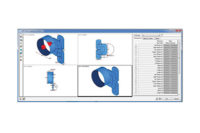Building information modeling is a process, not a product. However, technology is an enabler and recent enhancements in this area are helping MEP professionals realize the benefits of moving to BIM.
BIM is about collaboration and information, and helping drive more informed decision making. As it becomes a more established process, it is changing how to design and construct buildings. Governments and owners around the world are mandating its use in an attempt to reduce the capital expenditure of construction and improve whole-life building performance.
With increased BIM adoption, the industry also is beginning to understand its true value, which lies beyond 3D coordination modelling in creating, analyzing and disseminating information throughout the design, construction and operational phases of an asset. Technological enhancements are making this more achievable.
Collaboration
Demands for better integration and cross-discipline collaboration are increasing with the need for improved methods for sharing and exchanging information more easily, reliably and dynamically. This is being emphasized further by the desire to leverage the model for a variety of additional activities, such as energy analysis, simulation, computational design or cost estimation.
Enhancements in cloud computing allow designers to collaborate earlier in the process, improve communications and help generate better designs by enabling larger sets of data to be analysed more easily. Today, MEP engineers are able to collaborate with other project stakeholders concurrently regardless of physical location or time zone. They are instantly seeing the impact of architectural or structural changes on the model and are responding accordingly.
Speciality subcontractors can access models in the cloud via mobile devices in the field and record the quantity of services installed that day. They also can change the status of items in the model for office-based staff to act upon and increase the time associated with billing the completed works.
The cloud also is helping remove the complexity of IT setup and configuration across multiple devices, thus expanding the reach of information. Non-tech-savvy engineers now can open models in a browser from a URL emailed to them and navigate the model with ease.
Computational and rules-based design
With changes in technology and more flexible access to data, attitudes are shifting on how we collect, share and reuse our thoughts and ideas on design and construction. For many, BIM is becoming more about information and the ability to leverage the model to help inform design decisions. Computational design is a good example of this; recent enhancements have taken these tools beyond the realm of creating complex forms and structures and into automating repetitive processes for MEP applications.
Using industry-standard rules, terminal devices such as lights, grilles or sprinkler heads can be set-out relative to space geometry. If the space configuration changes, the model updates accordingly. Connecting elements in the model together, space parameters can be used to determine the required air flow, sizing and positioning of grilles. Subsequent changes to air flow automatically will update or replace grilles, highlighting them in the process and alerting designers to the change. For the specialty subcontractor, hangers can be positioned along a duct or pipe run according to specific construction rules, taking shape and size into account when instancing the appropriate hanger type.
This interactive approach to design is helping project stakeholders gauge the impact of changes, thus highlighting the need to collaborate earlier on projects. It also is helping capture the information used to finalize decisions that would previously have been lost.
Rules-based design also is helping aid modelling to Level of Development (LED) 400 and 500, as model authoring tools extend their offerings from design to detailing. MEP systems’ installation logic is being captured through customizable tools that enable companies to define how elements will connect and interact within the model, reflecting real-world scenarios. This allows detailers to focus on coordination and installation modelling tasks and have confidence that key components (such as flange types, gaskets, welds, etc.) will be instantiated as needed.
Rules can be defined on how to handle the connection of specific materials, for example ensuring dielectric unions are added when needed or that the placement of a particular value includes accompanying flanges, gaskets and associated accessories ensuring bill of materials take-off or estimating tasks performed downstream include the necessary items.
These technological enhancements also may help engineers and designers deliver more accurate, coordinated and constructible models through in-built logic, albeit generic models that subsequently get further developed by the contractor.
Simulation
As BIM becomes commonplace, users increasingly are exploring how the model can be leveraged for additional design-related activities. Interestingly, recent technological enhancements also are making established but often overlooked tools more prevalent. For example, simulation allows for better designs by enabling rapid iteration of ideas. The almost limitless computational power of the cloud is making simulation more viable as multiple iterations are now feasible in acceptable timeframes.
With increasing pressure to deliver greener, smarter and more efficient buildings, the use of simulation tools for energy analysis, solar and daylighting studies has become commonplace and a core component of BIM. Models prepared by the architect now can be leveraged by the MEP professional without the need to remodel. However, simulation for activities such as computational fluid dynamics previously has been the purview of specialists, but expensive and difficult to implement, and subject to lengthy results cycles. This is changing. These tools now are able to leverage existing services models and aid more informed design decisions.
For engineers, simulation tools such as these can help predict the effects of fluid flow throughout the services network leading to optimized equipment sizing. For the specialty subcontractor, these tools help achieve better pipe and duct network performance by simulating how systems will perform when subjected to different operating conditions or routing solutions. It’s possible to measure the effects of controls on the network (i.e. valves or dampers), analyze working pressures in the system and heat transfer, thus helping determine insulation requirements (i.e. grades, locations and quantity). These are processes that not only are enabling better designs, but more effectively are helping to manage materials.
Technological enhancements are enabling smarter, more informed decisions throughout design and construction, driving increased BIM adoption among MEP professionals. However, it is important to note technology is only a part of the solution. BIM requires a cultural shift in both company and industry practices. Implementing the right technology for the right reasons with clear and realistic goals will certainly make this transition easier.
This article was originally titled “Spurring growth” in the August 2015 print edition of PM Engineer.
Author bio: Steven Butler is an industry strategy manager, MEP & Fabrication with Autodesk. Prior to joining the company, Butler worked in the industry for consultants, contractors and manufacturers in various capacities in addition to working for an Autodesk MEP third-party developer. He can be reached at steven.butler@autodesk.com.





